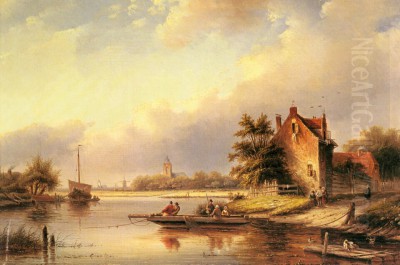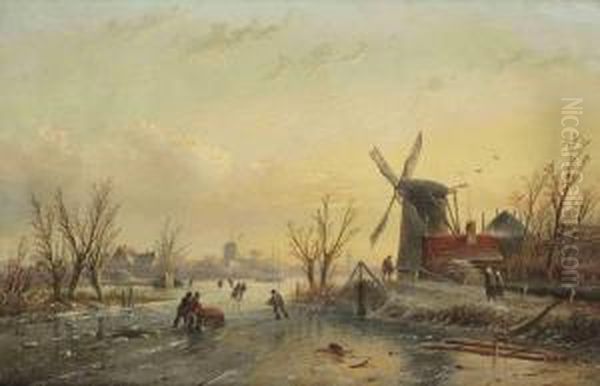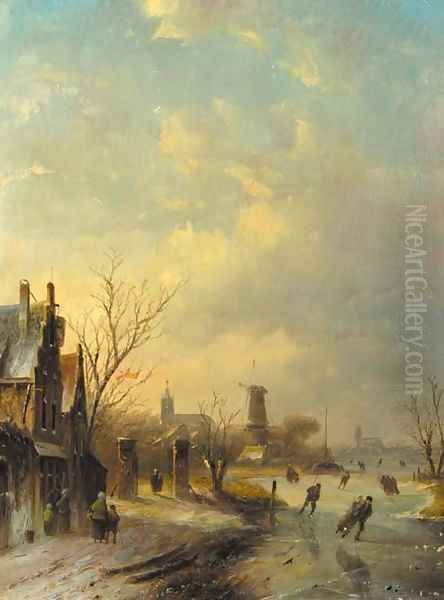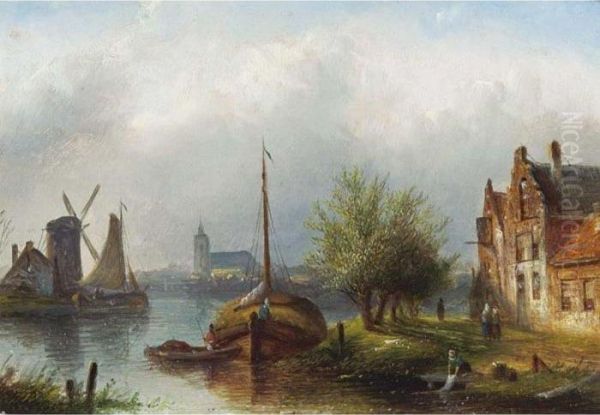
Jan Jacob Coenraad Spohler stands as a notable figure in the rich tapestry of 19th-century Dutch art. Born in 1837 and living until 1923, his life spanned a period of significant artistic evolution in the Netherlands. He dedicated his career primarily to landscape painting, developing a particular affinity for capturing the unique atmosphere of his homeland, especially its picturesque winter scenes and tranquil summer vistas. As an artist working within the later phase of the Dutch Romantic movement, Spohler's work embodies a deep appreciation for nature, meticulous observation, and a desire to convey the characteristic charm of the Dutch environment.
His paintings, often featuring frozen canals bustling with skaters or serene river views under summer skies, continue to be admired for their technical skill, atmospheric depth, and nostalgic portrayal of Dutch life. Understanding J.J.C. Spohler requires looking not only at his individual output but also at the artistic family he belonged to and the broader context of Dutch painting during his time.
A Family Legacy in Art
Artistic talent often ran in families, and the Spohlers were a prime example in the 19th-century Netherlands. Jan Jacob Coenraad Spohler was the son of Jan Jacob Spohler (1811-1866), who was himself a well-regarded landscape painter. The elder Spohler established the family's artistic reputation, specializing in both summer and winter landscapes that captured the Dutch countryside with sensitivity and skill. He received formal training, notably studying under the history and portrait painter Jan Willem Pieneman, a prominent figure in Amsterdam's art scene. In 1845, Jan Jacob Spohler (the father) became a member of the prestigious Koninklijke Akademie van Beeldende Kunsten (Royal Academy of Visual Arts) in Amsterdam.
Growing up in such an environment undoubtedly shaped Jan Jacob Coenraad's path. He received his primary artistic instruction directly from his father, learning the techniques and thematic preferences that characterized the family's output. This apprenticeship grounded him in the traditions of Dutch landscape painting, emphasizing careful drawing, balanced composition, and the effective rendering of light and atmosphere.

The artistic lineage extended further with Jan Jacob Coenraad's younger brother, Johannes Franciscus Spohler (1853-1894). While also a painter influenced by the family tradition, Johannes Franciscus developed a slightly different focus, becoming particularly known for his detailed and lively cityscapes, often depicting the streets and canals of Amsterdam. Though their specializations diverged somewhat, both brothers contributed to the continuation of representational painting in the Netherlands, working in styles that appealed to the tastes of the time. The Spohler family, therefore, represents a fascinating instance of inherited artistic inclination and shared professional identity within the Dutch art world.
The Dutch Romantic Context
Jan Jacob Coenraad Spohler's artistic career unfolded during the latter part of the Dutch Romantic period. This movement, flourishing roughly from the 1820s to the 1870s, saw artists turning away from Neoclassicism towards a more personal and evocative depiction of the world, particularly nature and national heritage. Unlike the dramatic, often sublime landscapes of German or British Romanticism, the Dutch variant was generally calmer, more intimate, and deeply rooted in the country's own artistic traditions and recognizable scenery.
Artists of Dutch Romanticism sought to capture the specific character – the genius loci – of their homeland. They painted windmills, canals, rivers, forests, beaches, and town views, often imbuing them with a sense of idealized tranquility or picturesque charm. There was a renewed appreciation for the masters of the Dutch Golden Age (17th century), particularly landscape painters like Jacob van Ruisdael and Meindert Hobbema, whose works served as inspiration for depicting the local environment with sensitivity.
Key figures who defined Dutch Romantic landscape painting include Barend Cornelis Koekkoek, often called the "Prince of Landscape Painters," known for his meticulously detailed forest and winter scenes, and Andreas Schelfhout, a master of the winter landscape whose influence is clearly visible in the work of many subsequent artists, including the Spohlers. Other important contemporaries included Wijnand Nuijen, known for his vibrant landscapes and coastal scenes before his early death, and Cornelis Springer, who excelled in detailed, sunlit townscapes that shared a similar attention to detail and atmosphere found in landscape painting. Salomon Verveer was another prominent figure, known for his lively depictions of Dutch town and beach scenes. J.J.C. Spohler worked firmly within this tradition, focusing on the accurate yet atmospheric portrayal of familiar Dutch settings.
Mastering the Winter Scene

While J.J.C. Spohler painted various types of landscapes, he became particularly renowned for his winter scenes. This specialization placed him in a long and cherished tradition within Dutch art. The depiction of winter, especially frozen waterways alive with activity, had been popularized during the 17th century by artists like Hendrick Avercamp and Aert van der Neer. These scenes resonated with the Dutch experience, where frozen canals and rivers historically transformed into vital social spaces for travel, transport, and recreation.
In the 19th century, this theme experienced a resurgence, partly fueled by Romantic nostalgia and the picturesque qualities of snow and ice. Andreas Schelfhout was a pivotal figure in reviving the genre, and his influence permeated the work of many, including Jan Jacob Spohler senior and, subsequently, J.J.C. Spohler. J.J.C.'s winter landscapes typically feature wide, frozen rivers or canals under expansive, often grey or subtly lit skies. The ice surface is rarely empty; it teems with figures skating, pushing sleds, conversing, or engaging in other winter activities.
His paintings like Skaters on the Ice or the numerous works titled Winter Landscape with Skaters exemplify his approach. He paid close attention to the details of winter life: the bundled clothing of the figures, the textures of snow and ice, the bare branches of trees against the sky, and often, a village or town skyline in the distance, complete with windmills or church spires. He skillfully rendered the specific light of winter – often cool, diffused light reflecting off the snow and ice, creating a convincing sense of cold air and quietude, even amidst the lively human activity. These works captured a quintessential aspect of Dutch identity and landscape, making them highly popular with collectors both domestically and abroad. Other painters like Charles Leickert and Louis Apol also excelled in this genre, each bringing their own nuance to the depiction of the Dutch winter.
Beyond the Ice: Summer Landscapes and Technique
Although best known for his winter scenes, Jan Jacob Coenraad Spohler was also adept at capturing the Dutch landscape during warmer months. His summer scenes often depict tranquil riversides, canal banks dotted with cottages and windmills, or ferry crossings under bright or softly clouded skies. Works like A Summer's Day at the Ferry Crossing showcase this aspect of his oeuvre. In these paintings, the palette shifts to warmer greens, blues, and earth tones, and the focus moves to depicting lush foliage, calm water reflecting the sky, and the gentle light of a Dutch summer.

Regardless of the season, Spohler's technique remained consistent in its emphasis on careful execution and detail. He employed fine brushwork to render textures accurately, whether it be the rough surface of ice, the smooth flow of water, the intricate details of architecture, or the varied forms of trees and clouds. His compositions are typically well-balanced, often using waterways or paths to lead the viewer's eye into the scene. Figures, though often small in scale within the larger landscape, are depicted with care, adding life and narrative interest to the views.
His handling of light was crucial to the atmosphere of his paintings. In winter scenes, he captured the subtle variations of light on snow and ice. In summer scenes, he adeptly rendered the play of sunlight and shadow, creating a sense of depth and realism. While adhering to the detailed realism favoured by the Romantics, his work avoids photographic rigidity, retaining a painterly quality and an evocative mood. His style, while clearly indebted to his father and artists like Schelfhout, possesses its own distinct character, often marked by a slightly brighter palette and lively figural arrangements compared to some of his contemporaries.
Travels, Exhibitions, and Professional Life
Like many artists of his time, Jan Jacob Coenraad Spohler did not remain fixed in one location throughout his career. While Amsterdam, his birthplace, remained a central hub, records indicate he also worked in other Dutch cities, including Haarlem, The Hague, Leiden, and Rotterdam. He is also documented as having spent time in Brussels, Belgium. This mobility likely broadened his range of subjects and exposed him to different artistic currents and patronage networks.
Participation in exhibitions was crucial for an artist's visibility and reputation in the 19th century. J.J.C. Spohler, following in his father's footsteps, likely exhibited his works regularly at venues such as the periodic 'Tentoonstelling van Levende Meesters' (Exhibitions of Living Masters). These exhibitions were held in major Dutch cities like Amsterdam, The Hague, and Rotterdam, providing artists with opportunities to showcase their latest creations to the public and potential buyers. His membership or association with institutions like the Amsterdam Royal Academy (inherited from his father's connection) would have facilitated participation in such events.
The consistent quality and appealing subject matter of his work ensured a steady market. His paintings, particularly the charming winter scenes, catered to the tastes of the burgeoning middle class, who sought pleasant, recognizable depictions of their country to adorn their homes. This sustained demand contributed to a productive and relatively stable career.
Market Recognition and Enduring Legacy

The appeal of Jan Jacob Coenraad Spohler's work has endured well beyond his lifetime. His paintings continue to be sought after in the art market, frequently appearing at auctions in Europe and North America. Prices for his works, especially well-preserved and characteristic winter landscapes, reflect their desirability among collectors of 19th-century European art. For instance, paintings like Dutch Skaters on a Frozen Waterway have fetched significant sums, demonstrating the lasting appreciation for his skill and chosen subjects. Auction results consistently place him as a respected, collectible artist within the Dutch Romantic school.
While perhaps not reaching the absolute pinnacle of fame occupied by B.C. Koekkoek or Andreas Schelfhout, J.J.C. Spohler holds a secure place in the history of Dutch landscape painting. His works are represented in various public and private collections, although careful attribution is sometimes needed to distinguish his work from that of his father, Jan Jacob, and his brother, Johannes Franciscus, due to similarities in style and subject matter, particularly between father and son. Museums like the Teylers Museum in Haarlem and potentially others hold works by the Spohler family, contributing to the preservation of their legacy.
His primary contribution lies in his consistent production of high-quality, atmospheric landscapes that beautifully capture the essence of the Netherlands. He skillfully synthesized the detailed realism inherited from the Golden Age with the evocative mood of Romanticism. Alongside contemporaries like the aforementioned Charles Leickert, and bridging towards the later Hague School painters such as Johannes Bosboom or early works by Anton Mauve and Willem Roelofs who shifted towards a looser, more atmospheric style, Spohler represents the continuation of a specific, highly popular mode of landscape painting in the 19th century.
Conclusion: A Painter of Dutch Charm
Jan Jacob Coenraad Spohler dedicated his long artistic career to celebrating the landscapes of his native Netherlands. Working within the established traditions of Dutch Romanticism and heavily influenced by his artist father, he developed a distinctive and appealing style. He excelled particularly in the depiction of winter scenes, capturing the unique light, atmosphere, and social activities associated with the frozen waterways of Holland. His paintings are characterized by meticulous detail, skillful rendering of light and texture, and balanced, picturesque compositions.
Though he also painted capable summer landscapes, it is his winter scenes, filled with skaters and snowy vistas under broad Dutch skies, that form the core of his legacy. These works evoke a sense of nostalgia and national identity, continuing a tradition stretching back to the 17th century while embodying the specific sensibilities of 19th-century Romanticism. As a member of a notable artistic family and a respected practitioner within his field, Jan Jacob Coenraad Spohler remains an important figure for understanding the evolution of Dutch landscape painting, admired for his technical proficiency and the enduring charm of his vision of the Netherlands. His work offers a window onto a picturesque past, rendered with affection and considerable skill.